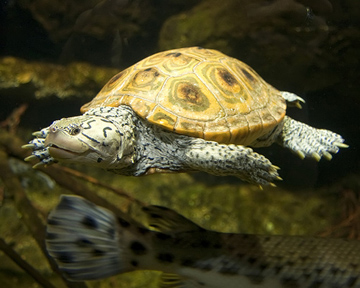In the early 1900s, one of the great delicacies of American cuisine was turtle soup — a mixture of turtle meat, cream, and wine. But turtle soup began disappearing from American tables in the 1930s and ’40s — mainly because one of the main ingredients was all but gone: a turtle known as the diamondback terrapin. Overfishing had practically wiped out the little reptile.
 For diamondback terrapins today, habitat destruction is a bigger threat than being caught for turtle soup. Credit: US Fish and Wildlife Service
For diamondback terrapins today, habitat destruction is a bigger threat than being caught for turtle soup. Credit: US Fish and Wildlife ServiceThe terrapin is found from Cape Cod to the Florida Keys to the central Texas coast. It lives in lagoons, marshes, shallow bays, and other brackish environments. In fact, it’s the only turtle in the world that’s known to live exclusively in brackish waters.
Terrapins are quite small. Females grow to about seven or eight inches in length, with males only about half that size. Their shells are decorated with patterns of diamonds — hence the “diamondback” part of the name. And like fingerprints, no two shell patterns are the same.
Terrapins lay their eggs on sandy beaches, and they never stray far from their birthplace. Those in colder climates hibernate during winter by burrowing into the mud at the bottom of tidal creeks.
Turtle soup isn’t very popular these days, but the terrapin still faces threats from people. Coastal development destroys habitat, and they’re often caught and drowned in crab traps. They can even be threatened by airplanes. JFK airport in New York is building a barrier to keep out the hundreds of terrapins that cross one of its runways every summer — keeping this one-time delicacy out of harm’s way.
This episode of Science and the Sea was made possible by Texas Sea Grant.

